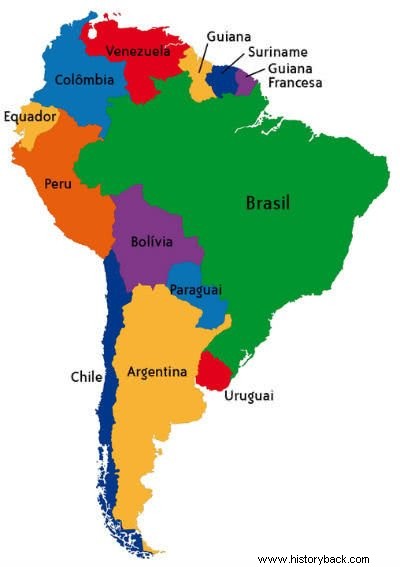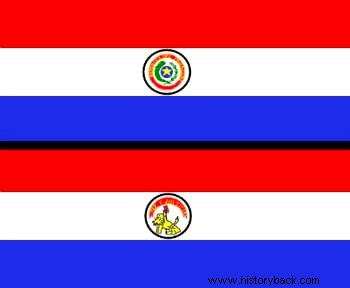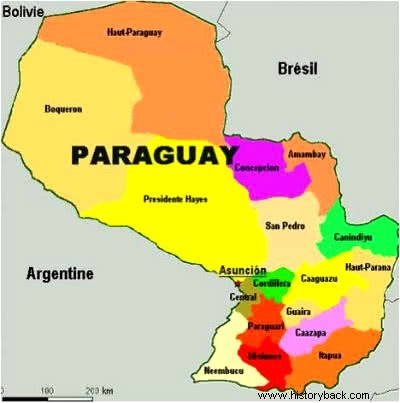The Paraguay , whose official name is the Republic of Paraguay, is a country located in South America.
Along with Bolivia, it is one of the two countries on the continent that does not have an outlet to the sea.
It borders Argentina, Bolivia and Brazil. Paraná and Mato Grosso do Sul are Brazilian states that border Paraguay.
The name Paraguay, of Guarani origin, refers to the river in the region.

General Data
- Capital: Assumption
- Territorial Extent: 406 752 km²
- Population: 6 854 536
- Weather: subtropical
- Languages: Guaraní and Spanish
- Religion: Catholicism and Indigenous Beliefs.
- Currency: Paraguayan Guarani
- Government system: presidential republic
Flag

The flag of Paraguay has the colors blue, white and red in horizontal bands with a shield in the center.
Unlike most flags, the two sides are not identical. Therefore, on the back we have a shield with a star, olive branches and the inscription “República del Paraguay”. On the reverse, the shield bears the figure of a lion.
There are several explanations for the origin of the colors of the Paraguayan flag. One of them would be that they were the same ones used in the uniforms of the Paraguayan soldiers who defended the Rio de la Plata against the British invasions in 1806.
Another accepted theory is the reference to the French revolutionary flag whose Enlightenment ideals influenced the country's independence process.
Shields also have symbolism linked to independence. The Estrela de Maio is a reminder of the country's independence date:May 14, 1811. On the other hand, the symbol of the lion guarding the liberty cap represents the defense of national sovereignty.
We find the same star on the flags of Argentina and Uruguay. This is no coincidence, as these countries were part of the Viceroyalty of La Plata and began the process of independence from Spain at the same time.
Territorial Division
The country is divided into 17 departments and the Capital District.
- Alto Paraguay
- Alto Paraná
- Amambay
- Capital District
- Boqueron
- Caaguazú
- Caazapá
- Canindeyú
- Central
- Conception
- Cordillera
- Guairá
- Itapúa
- Missions
- Ñeembucú
- Paraguarí
- President Hayes
- San Pedro

The Paraguayan economy is based on livestock and agriculture, especially soy.
Culture
Paraguay still proudly guards its indigenous past. The Guarani language is spoken by a large part of the population along with Spanish. In this way we see marks of the Guarani culture in all artistic areas mixed with the customs brought by the Spanish colonizers.
The country preserves folkloric dances such as the yuki, pericón, Paraguayan polka and Chiperita, among others. Several are mixtures of European and indigenous rhythms that are performed with traditional clothes.
In musical terms, the Paraguayan harp stands out. The instrument was introduced by the Jesuits and accompanies chants in Guarani, Spanish and some typical dances.
In Paraguayan literature there are poets and writers who used Guarani and Spanish to express themselves. Authors such as Augusto Roa Bastos, Gloria del Paraguay and Ignacio E. Pane stand out.
The cuisine is rich in vegetables and meats, combining indigenous traditions with Spanish and Italian influences. One of the typical dishes is "vorí vorí" or "borí borí" which is basically a thick broth accompanied by small balls of corn flour and cheese.
As in Argentina and Uruguay, the most appreciated typical drink is mate.
Sights
The capital Asunción concentrates a good part of the cultural offer such as theaters and museums. We can mention the Independence House, the Clay Museum, the National Pantheon and the Cathedral of Nossa Senhora da Assunção.
In the department of Encarnación it is possible to visit the Jesuit Ruins of Tavarangue and Santíssima Trindade. There are also river beaches like San Juan.
For those who like to enjoy nature, Paraguay has spectacular landscapes such as Cerro Akati and Cerro Tres Kandu or Peró.
See also:Spanish colonization